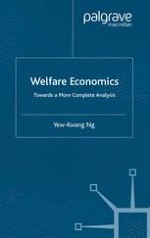2004 | OriginalPaper | Buchkapitel
The Optimal Distribution of Income
verfasst von : Yew-Kwang Ng
Erschienen in: Welfare Economics
Verlag: Palgrave Macmillan UK
Enthalten in: Professional Book Archive
Aktivieren Sie unsere intelligente Suche, um passende Fachinhalte oder Patente zu finden.
Wählen Sie Textabschnitte aus um mit Künstlicher Intelligenz passenden Patente zu finden. powered by
Markieren Sie Textabschnitte, um KI-gestützt weitere passende Inhalte zu finden. powered by
What is the optimal distribution of income? As with any constrained optimisation problem, this depends on the form of the objective function and of the constraint. Since we are interested in optimality from the social point of view, the relevant objective function is the SWF. Since a reasonable SWF does not exist without an interpersonal comparison of cardinal utility (Chapter 5), the interpersonal cardinal utility approach is used in this chapter. The relevant constraint can be expressed as a utility possibility frontier if we agree that social welfare is a function of individual utilities (or individual welfares — abstracting away the differences between preference and welfare, the two are equivalent; see Section 1.3). Factors other than individual utilities are either regarded as not relevant to social welfare or are held constant. In Section 2.2.1 we derived a utility possibility frontier by taking the outer envelope of the numerous utility possibility curves, each corresponding to a specific collection of goods. This could be regarded as rather restrictive or purely economic, since by varying only the collection of goods other factors (social and so on) must be held constant. By changing these other factors, a different utility possibility frontier may emerge. Conceptually this generalisation can easily be taken into account by taking the outer envelope of the various utility possibility frontiers and calling it the grand utility possibility frontier.
